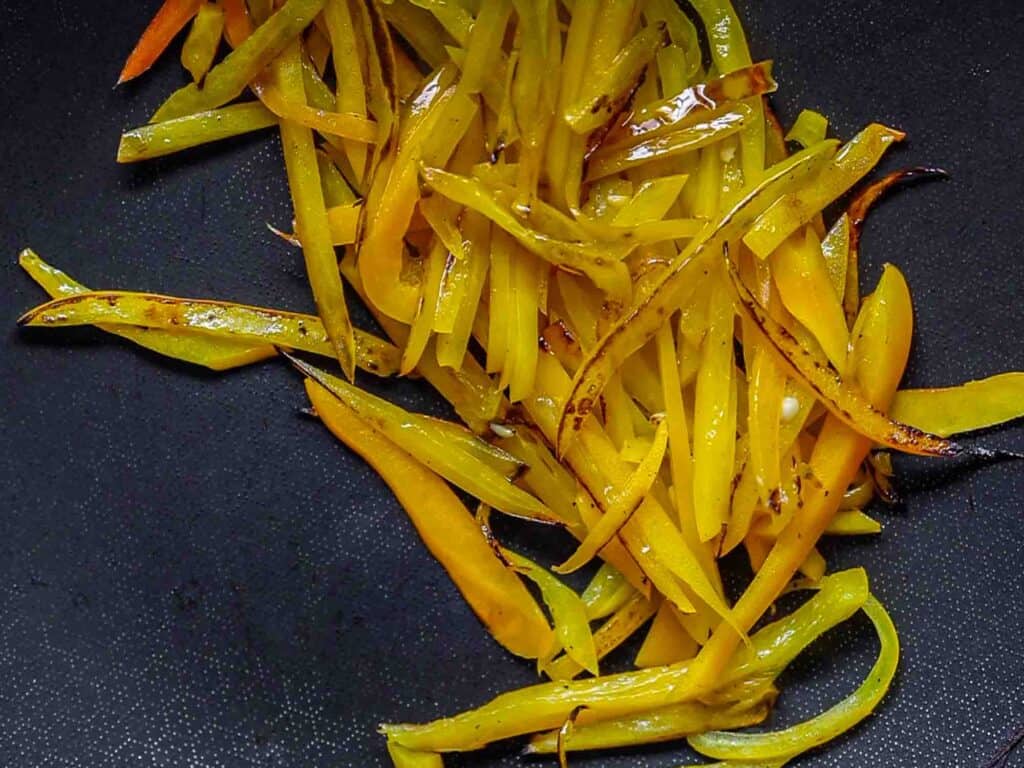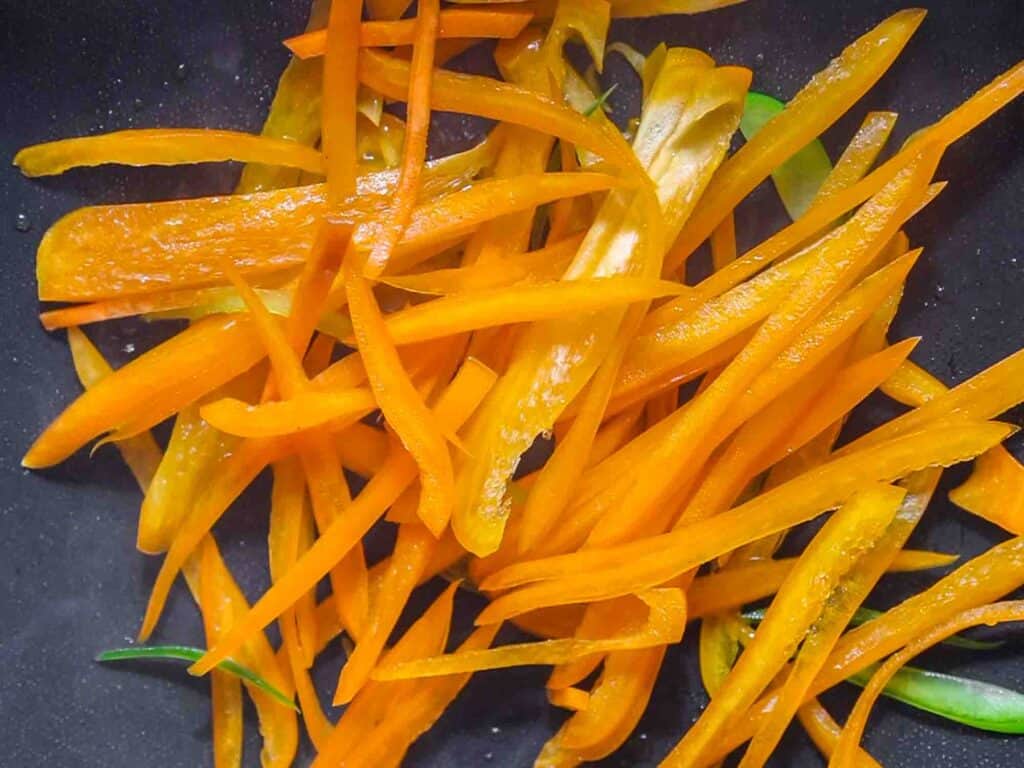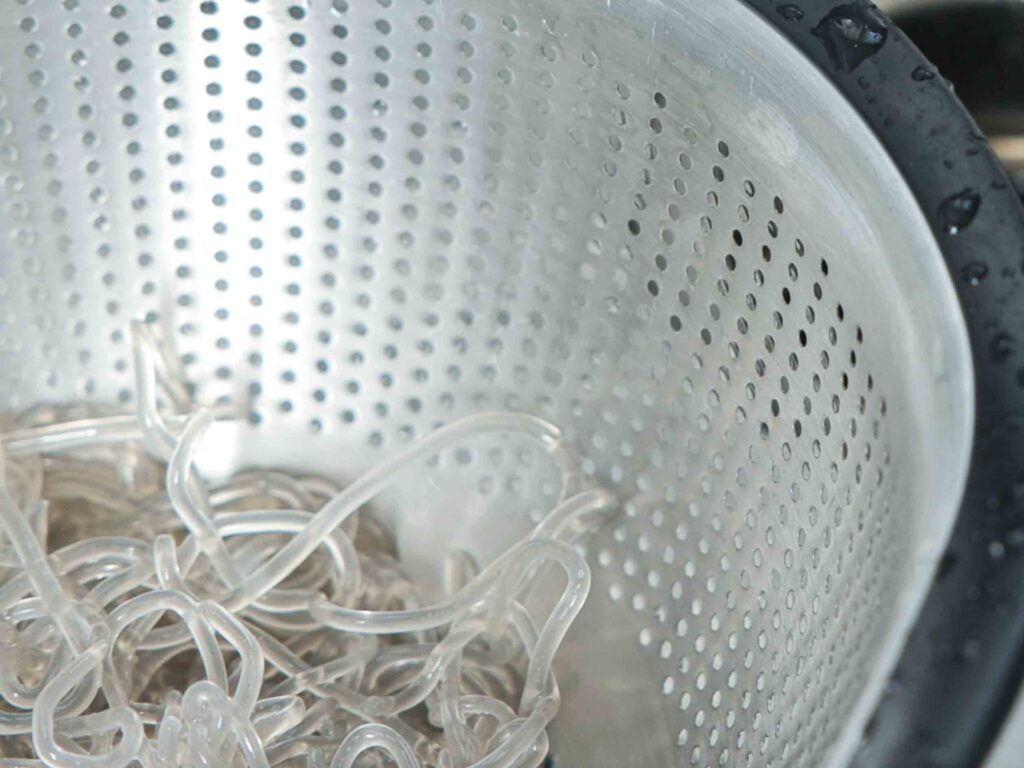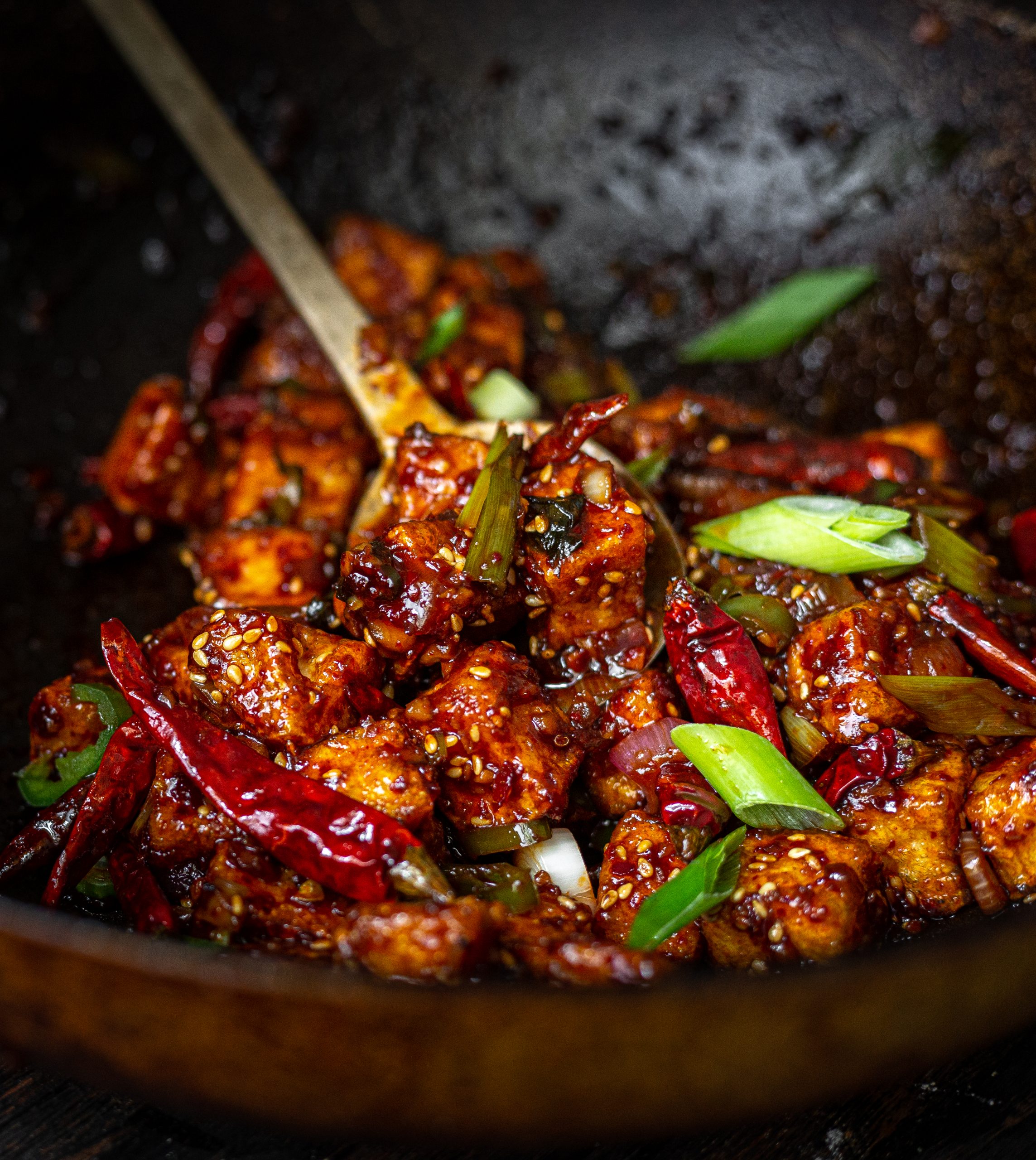
Colorful.
Delicious.
Gluten-free.
Vegetarian japchae.
Actually, as is the case for all things on this blog, it’s technically a vegan japchae recipe. But, for so much of traditional Korean cuisine, “vegetarian” and “vegan” are often interchangeable, since traditional Korean food is largely dairy free (just like with this vegetarian japchae!).
I’ve developed a “healthier” version for everyday eats, but this one–this is the one I make for birthdays, holidays, or dinner parties. In fact, I made this vegetarian japchae for Chuseok (Korean Thanksgiving) as well as American Thanksgiving! It’s an absolute staple of the holiday table in our family. It’s still exceptionally healthy (with all the antioxidants!), but it’s a bit richer and heartier. This is the version they were serving in the palaces of the Chosun Dynasty and now, you can have it in your palace!
So, let’s get to it!
Disclaimer: Some of the links in this post may be affiliate links for products I use and love. If you make a purchase after clicking one of those links, I may earn a small affiliate commission, perhaps enough to buy some extra gochujang or gochugaru 🙂
What is Japchae?

As I talked about here, Korean japchae, often described as “stir-fried glass noodles” or “Korean glass noodles,” consists of long, bouncy noodles that are made out of sweet potato starch, mixed with a variety of vegetables like spinach, onions, and bell peppers. Because the glass noodles (referred to as “dangmyeon” or “dangmyeon noodles”) are made from sweet potato starch (and not wheat flour), they are naturally gluten-free. Hence, if you use gluten-free soy sauce for this vegetarian japchae, this entire Korean dish is gluten-free.
If you’ve recently been to a local Korean grocery store, Korean buffet, or other Korean restaurant, you will almost always see some version of japchae on the menu, though very rarely will it be vegetarian japchae. It is one of the most well-known Korean dishes and often shows up at holiday potlucks or birthday parties. Not only is japchae one of the most popular dishes in Korea, it is also one of the most popular recipes out of my cookbook!
What makes traditional japchae not vegan or vegetarian? Traditional japchae incorporates bulgogi (Korean BBQ flank steak) or some other type of beef. My mom tells me that sometimes, you’ll even find japchae with pork (very rare) or shrimp (very fancy!). This vegetarian japchae recipe will include a meatless Korean BBQ alternative (Plantspired) that I truly ADORE and one my family thinks is AMAZING (they always get excited when I bust it out for dinner time). My other vegan version of japchae incorporates a healthy plant-based protein–tofu! But for this version, I wanted to stay as close to the traditional Korean noodle dish of my childhood as possible.
Is japchae considered a “main course” or a “side dish”? Technically speaking, japchae is one of many “banchan” or side dishes in Korean cuisine that is typically served with a bowl of rice. I know–carbs and carbs! But that is not atypical in Korean food! Usually Korean noodles are meals in and of themselves (e.g., jjajangmyeon, jjolmyeon, naengmyeon, kimchi guksu); but perhaps because these noodles are not made from wheat (and thus considered to be lighter than their wheat-based counterparts), japchae has always fallen in the “banchan” category. But if you want to make it the “main dish” of your meal, more power to ya!
What Does Vegetarian Japchae Taste Like?

Vegetarian japchae, when made correctly, will taste almost indistinguishable from japchae made the traditional way. What does traditional japchae taste like?
Well, first, let’s discuss texture. What do Korean sweet potato noodles taste like? They are chewy and extremely elastic. They remind me a lot of rice vermicelli or rice noodles, only they are chewier. If they are boiled for too long, though, they will get overly soft and unpleasant. In fact, many Korean ajummas take pride in how chewy and bouncy they can make their noodles. We’ll discuss this more when we talk about the cooking process for making this vegetarian japchae.
In terms of flavor, japchae is as much about the vegetables as it is about the savory japchae sauce. As you will see, this vegetarian japchae, just like the traditional version, will include a ton of bright bell peppers, onion, mushrooms, and spinach. The key, however, is to cook each of these vegetables separately, to make sure that none of the flavors gets muddled. Japchae is truly about a symphony of flavors, not a blend of flavors.
The japchae sauce is a simple one and is a simplified version of the sauce we make for Korean BBQ. Think teriyaki sauce, only less sweet and less thick.
Key Ingredients and Notes on Potential Substitutions for Vegetarian Japchae.
The following are some recommended substitutions to certain ingredients for this vegetarian japchae:
Glass Noodles. Although Korean sweet potato starch noodles are an essential component of vegetarian japchae, if you can’t get your hands on dangmyeon, you can substitute with rice noodles. Try and find some that are similar in width to Korean glass noodles, which are roughly the diameter of spaghetti.

Planspired Steak (Optional). My mom tells me that meatless japchae is becoming way more popular in Korea these days, but the version I grew up on almost always had bulgogi or Korean BBQ flank steak. Accordingly, this vegetarian version includes one of the few “meat substitutes” I enjoy, and it’s one my non-vegan family LOVES: Plantspired Korean BBQ Steak. To me, it tastes virtually identical to Korean BBQ and it’s super easy to use since it’s already pre-marinated in Korean BBQ sauce.
If you don’t have Plantspired Steak, you can use whatever kind of meat alternative you’re used to or just skip it–the last time I made vegetarian japchae I skipped it and it still turned out fit for a king!!
Shiitake Mushrooms. Traditional japchae includes shiitake mushrooms and this vegetarian version does, as well. However, if you don’t have easy access to shiitake mushrooms, you can use whatever mushrooms you can find–portobello, cremini, button, even enoki or trumpet mushrooms would be great in japchae!

Onion. I LOVE the flavor the onions provide in this vegetarian japchae, especially when cooked together with the shiitake mushrooms. For this vegetarian recipe, I like a plain old yellow onion. However, if you don’t like onions, you can skip them. You can also replace them with scallion whites, if you prefer a more delicate onion-y flavor. Some recipes use green onions, but my mom tells me using both here (both regular onion and green onion) would be overkill.
Spinach. Traditional japchae utilizes spinach as its source of leafy green, but don’t let that stop you from incorporating your favorite green. I love subbing with kale, broccoli, swiss chard, collard greens, bok choy! You can boil them or stir-fry them–whatever is your pleasure! My only warning is to avoid using baby spinach. Baby spinach gets extremely soggy (even slimy) when cooked, so stick with a sturdier green!
Bell Peppers. As you can see, japchae is an extraordinarily colorful dish. In fact, it’s the bounty of vegetables that makes this dish fit for a palace! Where do we get all these colors? Bell peppers. Specifically, this vegetarian japchae includes red bell pepper, yellow bell pepper, orange bell pepper, and green bell pepper. It’s certainly not the end of the world if you don’t have all four of these colors included in your vegetarian japchae; but, you should have at least the red pepper, since there won’t be any other red ingredients in the dish!

Carrot. In addition to bell peppers, japchae almost always has carrots, as does this vegetarian japchae. If you don’t like carrots, you can certainly omit them, although you’ll want to make sure, then, that you have some orange bell pepper included for the color!
Soy Sauce. If you are trying to keep this recipe gluten-free, make sure to pick out a good gluten-free soy sauce. If you are allergic to soy, there are some great no-soy alternatives, including this no-soy, gluten-free sauce. You can, of course, also use coconut aminos.
Brown Sugar. For the sauce, my mom likes to use a mix of sweeteners: brown sugar and brown rice syrup (see below). This is actually quite typical of a lot of Korean cooking–the utilization of multiple different kinds of sweeteners. If you don’t have brown sugar, you can, of course, use white sugar, though you’ll miss out on some of the earthier notes the brown sugar imparts. You can also just skip refined sugar altogether and use a syrup (see note below)!
Brown Rice Syrup. Traditionally, my mom and aunts use brown rice syrup to make their japchae. If you don’t have access to brown rice syrup, you can substitute your favorite unrefined sweetener: maple, coconut sugar, date sugar, etc.
Toasted Sesame Oil. Toasted sesame oil is a critical component to creating the right flavor for this vegetarian japchae. Therefore, it’s not one that I would skip or replace. However, if you really can’t get your hands on a toasted sesame oil (not a cold pressed one!!), just double up on the toasted sesame seeds.
Toasted Sesame Seeds. In order to add one final “crunch” to this delicious recipe, this vegetarian japchae calls for toasted sesame seeds as garnish. Again, the sesame flavor is one of the hallmarks of japchae, so it isn’t one you should easily forego. However, if you can’t get any toasted sesame seeds, you can omit them. Don’t try compensating for their absence by adding toasted sesame oil! Adding too much oil will disrupt the balance of the sauce, as toasted sesame oil is very powerful!
Step-by-Step Instructions for Making this Vegetarian Japchae.
Step 1. Cook the spinach by bringing a large pot of water to a boil. Drop the spinach in and let it cook for about 1 minute, until the leaves turn a bright and brilliant green. Drain and run the spinach under cold water, to stop it from cooking longer. Squeeze out the excess liquid and place the spinach in a very large bowl. Add a little soy sauce, sesame oil, black pepper, and sesame seeds and mix in until well-combined. Set aside.



Step 2. Next, julienne everything. And by everything, I mean, the Plantspired steak, onion, mushrooms, carrots, and bell peppers. When I’m making japchae for a dinner party, I make sure the vegetables are extremely skinny. I do this by creating very thin layers of bell pepper and carrot (you can use a mandolin) and then julienning them. But do the best you can and chop them into whatever sized matchsticks your knife skills can achieve efficiently and safely.





Step 3. Begin by sautéing the Plantspired steak, onions and mushrooms over medium-high heat in a little bit of extra virgin olive oil, salt, and pepper, until the onions grow translucent (around 3 to 5 minutes). If you’re not using Plantspired steak, add 1 tablespoon of soy sauce, 1 tablespoon of syrup, and black pepper and continue sauteeing until the liquid evaporates (about 1 minute).

Then, throw those in the same bowl with the spinach. Next, sauté the carrots in the same fashion–with a little olive oil, salt, and pepper, until they begin to soften (about 4 to 5 minutes). Add to the same bowl with the spinach and mushrooms. Repeat for the red bell pepper, then the green bell pepper, then the orange bell pepper, and finally the yellow bell pepper. The order doesn’t matter–so long as you cook each vegetable separately.





Step 4. To cook the noodles, bring a large pot of water to a boil and add your glass noodles. My mom tells me that the best way to ensure perfectly chewy noodles is to cook the noodles for about 3 minutes and then add 1/2 cup of cold water. When the water comes back to a boil, add another 1/2 cup of cold water. Continue doing this until your noodles are cooked (around 7 minutes in total). Before draining the excess water, reserve about 1 cup. Then drain the water, run the noodles under cold water (so they don’t get soggy), and place the noodles in the same pan as the stir-fried vegetables.

Step 5. To the large bowl of vegetables, add soy sauce, brown sugar, brown rice syrup, sesame oil, black pepper, and toasted sesame seeds. Then, add about 1/4 cup of the reserved noodle liquid. Using your hand or a pair of tongs, stir the sauce into the noodles, mixing vigorously to help thicken the sauce. I like my vegetarian japchae to have a bit of a broth (not swimming in broth, just “broth-y”) and if you do too, continue adding a bit more of that reserved noodle liquid at a time until you reach your desired consistency. The key is to stir it vigorously!





Step 6. Pour any remaining broth over the top of your noodles. Garnish your vegetarian japchae with a couple turns of cracked black pepper.


Want More Korean Holiday Recipes?
1
2
3
4
Tofu Stuffed Korean Zucchini Fritters.
A protein packed zucchini side dish you're going to love!
5
6
7
Easy & Hi-Protein Vegan Kimchi Jjigae.
Literally the best kimchi jjigae you'll ever eat in your life.
8
Gochujang Korean Zucchini Jjigae.
A delicious and spicy Korean zucchini stew to round out your perfect Korean meal!
9
Omma’s Gamja Jorim (Braised Potatoes)
If you love potatoes, you will love this dish, not only because it tastes amazing, but because it takes so little effort to prepare.
10
Frequently Asked Questions.
Can I make my vegetarian japchae in advance?
It’s best to prepare your vegetarian japchae right before you intend to serve it. The longer the noodles are exposed to room temperature, the harder they will become to eat.
How long can I store my vegetarian japchae?
If you somehow have leftovers after enjoying your vegetarian japchae, store them in an airtight container in the refrigerator for up to three days.
How can I reheat leftover vegetarian japchae?
Leftover vegetarian japchae can be reheated using the microwave or by stir-frying the leftovers in a little vegetable broth or water in a large pan over medium-high heat.
Recipe Card.

My Mom’s Easy Vegetarian Japchae (Korean Glass Noodles).
Joanne Molinaro
The perfect noodle dish for your holiday table!
Prep Time 15 minutes
Cook Time 30 minutes
Course Side Dish
Cuisine Korean
- 6 cups uncooked spinach
- 2 tbsp extra virgin olive oil
- 3 1/2 oz Plantspired Korean BBQ Steak (OR 1 tbsp soy sauce, 1 tbsp brown rice syrup, and 1/2 tsp black pepper)
- 1/2 cup sliced shiitake mushrooms
- 1/2 cup julienned yellow onion
- 2 tsp minced garlic
- 1/2 cup julienned red bell pepper
- 1/2 cup julienned green bell pepper
- 1/2 cup julienned orange bell pepper
- 1/2 cup julienned yellow bell pepper
- 1/2 cup julienned carrot
- 7 oz Korean sweet potato vermicelli
- 1/4 cup soy sauce
- 2 tbsp brown sugar
- 2 tbsp brown rice syrup
- 2 tbsp toasted sesame oil
- 2 tsp cracked black pepper `
- 1 tbsp toasted sesame seeds
Cook the spinach by bringing a large pot of water to a boil. Drop the spinach in and let it cook for about 1 minute, until the leaves turn a bright and brilliant green. Drain and run the spinach under cold water, to stop it from cooking longer. Squeeze out the excess liquid and place the spinach in a very large bowl.
Next, julienne everything: the Plantspired steak, onion, mushrooms, carrots, and bell peppers. For the bell peppers and carrot, create very thin layers (you can use a mandolin) and then chop them into matchsticks.
Begin by sautéing the Plantspired steak, onions and mushrooms over medium-high heat in a little bit of extra virgin olive oil, salt, and pepper, until the onions grow translucent (around 3 to 5 minutes). If you're not using Plantspired steak, add 1 tablespoon of soy sauce, 1 tablespoon of syrup, and black pepper and continue sauteeing until the liquid evaporates (about 1 minute). Then, throw those in the same bowl with the spinach. Next, sauté the carrots in the same fashion–with a little olive oil, salt, and pepper, until they begin to soften (about 4 to 5 minutes). Add to the same bowl with the spinach and mushrooms. Repeat for the red bell pepper, then the green bell pepper, then the orange bell pepper, and finally the yellow bell pepper. The order doesn't matter–so long as you cook each vegetable separately.
To cook the noodles, bring a large pot of water to a boil and add your glass noodles. My mom tells me that the best way to ensure perfectly chewy noodles is to cook the noodles for about 3 minutes and then add 1/2 cup of cold water. When the water comes back to a boil, add another 1/2 cup of cold water. Continue doing this until your noodles are cooked (around 7 minutes in total). Before draining the excess water, reserve about 1 cup. Then drain the water, run the noodles under cold water (so they don't get soggy), and place the noodles in the same pan as the stir-
To the large bowl of vegetables, add soy sauce, brown sugar, brown rice syrup, sesame oil, and black pepper. Then, add about 1/4 cup of the reserved noodle liquid. Using your hand or a pair of tongs, stir the sauce into the noodles, mixing vigorously to help thicken the sauce. I like my vegetarian japchae to have a bit of a broth (not swimming in broth, just "broth-y") and if you do too, continue adding a bit more of that reserved noodle liquid at a time until you reach your desired consistency. The key is to stir it vigorously!
Garnish your vegetarian japchae with toasted sesame seeds and a couple turns of cracked black pepper.
Keyword gluten free noodles, vegetarian japchae











 English (US) ·
English (US) ·